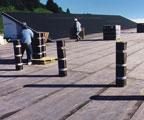 All flat roofing systems, no matter how well-constructed, well-designed, and well-installed, can only benefit from regularly scheduled upkeep. Semi-annual inspections combined with routine care can result in:
All flat roofing systems, no matter how well-constructed, well-designed, and well-installed, can only benefit from regularly scheduled upkeep. Semi-annual inspections combined with routine care can result in:
- Extended service life
- Fewer unanticipated problems
- Added security to building contents and tenants
- Keeping operating expenses within budget
- Permitting planning for future capital expenditures
A comprehensive roofing program that can be budgeted and funded properly is particularly helpful for building owners and managers who must justify expenses. Good maintenance practice calls for a minimum of two roof inspections per year — spring and fall. Inspection should also be performed after extreme weather episodes such as ice and snowstorms.
One of the best reasons to perform regular roofing inspection and maintenance is the potential long-term cost savings. With regular maintenance, it is possible that the life of a 20-year old roof can be extended to 30 years. That is a large payoff for a relatively small outlay of time and money.
When inspecting a roof, the following approach/checklist should be helpful:
- Remove debris and/or vegetation from roof surfaces
- Assure that there are no areas of ponded water
- Make sure that drains are clear
- Check clamping rings on drains for a secure fit
- Inspect caulking on metal flashings and pitch pans
- Visually inspect seams to establish that they are watertight (modified, EPDM)
- Observe ballast for wind scour (EPDM)
- Look for signs of puncture
- Top off pitch pans
- Examine areas around ventilators for damaged flashings
- Identify trends in traffic patterns and wear
- Examine for excessive cracks or blistering
Roof Replacement
No matter how well it has been maintained, every commercial roof in Boston must eventually be replaced. It is often difficult to decide whether to recover the old roof or tear it off and start from scratch. Avoiding removal of the old roof is the best option, depending on its condition.
Generally, if the roof is leaking, it must be torn off. Water penetration causes damage to the insulation and/or the roof deck. Covering a wet, leaking roof can lead to significant corrosion damage and the inevitable roof replacement, this time done appropriately. Typically, the roof must also be replaced when there is more than one roof over the deck (as the chances of trapping moisture increase with every layer of roofing material). In order to determine the feasibility of recovering an existing roof, contractors should perform a thorough visual inspection including tests cuts to determine the roof’s condition.
Replace or Repair?
Replace the roof if:
- It is leaking beyond repair
- There is excessive blistering
- Repairs become more frequent
- It is excessively delaminated
Repair the roof if:
- Its life can be extended
- Cracks/blisters/open seams are minimal
For more information about commercial roofing in Boston or flat roof maintenance, contact Abbot Building Restoration at 617-445-0274 today.


